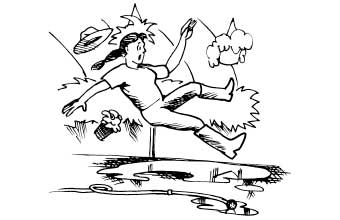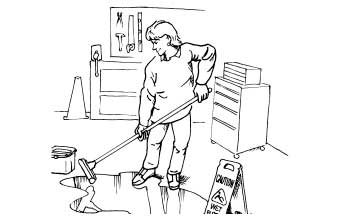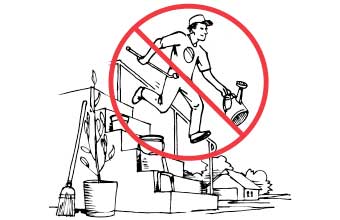Here are some key points:
- Most slips, trips, and falls can be prevented.
- Be on the lookout for such hazards as unsafe stairs, wet, slippery surfaces, and poor lighting.
- Immediately correct any hazards you spot or report them to your supervisor.
Be on the alert for hazards
Slips, trips, and falls are a major cause of accidents, both on and off the job. While some of these accidents are minor, others are serious. Many involve days away from work. Some may result in disabling injuries or even death. You can prevent slip-and-fall accidents by paying close attention to what you are doing and where you are going. Also, be on the constant lookout for these hazards:
- Obstacles in aisles and walkways, such as empty carts, boxes, electrical cords, hoses, or trash.
- Unsafe ladders or stairs.
- Uneven floor surfaces and rough outside terrain.
- Slippery surfaces, such as wet concrete and ice at entrances and parking lots during cold weather.
- Poor lighting
If you spot any of these hazards, immediately correct them or report them to your supervisor.
Tips to Prevent Falls
- Carefully inspect ladders before each use.
- Check stairways for loose or missing railings, broken or slippery stairs, and clutter.
- Wear shoes with nonskid soles, and don’t run.
- Don’t stand on boxes or chairs in place of ladders.
- Keep away from the edges of loading docks and other ledges.
- Don’t let objects you carry block your vision.
- Make sure you have adequate lighting.
- If you can’t remove an obstruction, walk around it – not on it.
- Wear proper clothing. Pants cuffs that are too long can catch on the heel of your shoe. Be sure your shoelaces are tied.
- Use steps – don’t jump!
Avoid Slipping and Tripping
- Watch out for wet surfaces. Chemical spills, grease, oil, water, and ice can result in dangerous walking conditions.
- Immediately report chemical spills to your supervisor. Clean up other spills as you spot them.
- Watch for icy conditions. Even a small amount of ice on the ground is hazardous. Sand or salt icy spots.
- When temperatures drop close to freezing, watch out for icy surfaces. Apply sand and/or ice melt to icy areas.
- Be wary of tile floors and recently polished floors. They can be very slippery.
- Keep your work area clean. Don’t store tools, pots, paint buckets, gasoline cans, packing material, or other items on the floor.
- Don’t leave cords or water hoses in walkways or across doorways.
- Always take a little extra time to sweep main walkways throughout the day. Debris and plant material can become slipping hazards.
- Be careful of loose pants cuffs and other loose clothing you could trip over.
- Keep all drawers closed.
More Safety Tips
- Don’t be in a big hurry. Never run up or down stairs.
- Always keep an eye out for potential hazards.
- Use both hands when climbing a ladder. Keep at least one hand and both feet on it while you’re working.
- Use the handrails on stairs.
- Don’t carry heavier loads than you can handle. Keep your balance when you are carrying a load. And maintain a clear field of vision so you can see where you are going.
- Put trash in its proper containers.
- Immediately notify your supervisor of any cracks in the flooring, holes or other hazards in need of repair.
- Be aware of the surface you are walking on. Some, such as outside terrain, can’t be corrected. Take extra care when walking on these surfaces.
Slips, Trips, and Falls Do’s and Don’ts
Do:
- Be on the constant lookout for such hazards as wet, slippery spots, and hoses or cords in walkways.
- Wear the appropriate work clothing, including shoes with nonskid soles.
- Pick up items that don’t belong on the floor.
Don't:
- Carry loads that are too heavy or loads that may block your vision.
- Use unsafe ladders or stairs, or run up and down stairs.
- Ignore potential hazards. Correct them or report them to your supervisor.
When you’re ready to work safely, you’re ready to work. See our full line of safety supplies, including respirators, eye and ear protection, coveralls, first aid, and more.
For more safety resources, click here.










